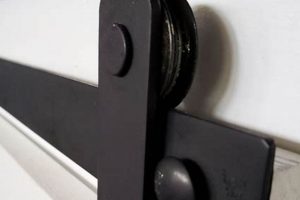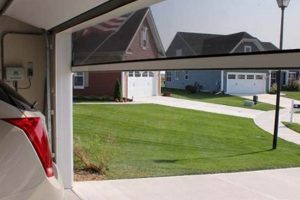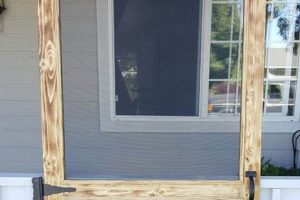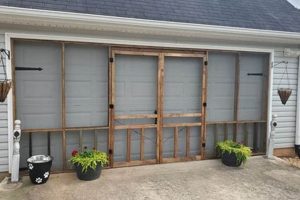The process of adding insulation to a garage door, undertaken as a do-it-yourself project, involves the homeowner procuring necessary materials and implementing the insulation installation independently. As an example, a homeowner might purchase insulation panels from a hardware store and adhere them to the interior of their garage door to mitigate temperature transfer.
Undertaking such a project can yield significant benefits, including improved energy efficiency within the home, reduced noise pollution emanating from the garage, and a more comfortable temperature within the garage space itself. Historically, homeowners have sought methods to improve home energy efficiency; garage door insulation represents a tangible means of achieving this goal.
The following sections will detail the required materials, the step-by-step installation process, safety considerations, and various insulation options available for improving a garage door’s thermal performance.
Practical Considerations for Garage Door Insulation
The following suggestions aim to optimize the effectiveness and longevity of a do-it-yourself garage door insulation project, contributing to improved energy efficiency and overall performance.
Tip 1: Measure Accurately: Before purchasing insulation, meticulous measurement of each garage door panel is crucial. Precise measurements minimize waste and ensure a snug fit, preventing gaps that compromise insulation effectiveness.
Tip 2: Select Appropriate Insulation Material: Different insulation materials offer varying R-values and are suited to different climates. Consider the local climate and desired level of insulation when choosing between fiberglass, foam board, or reflective insulation.
Tip 3: Clean the Door Surface Thoroughly: Proper adhesion of insulation material requires a clean and dry garage door surface. Remove any dirt, grease, or rust before beginning the insulation process.
Tip 4: Use Appropriate Adhesives: Select adhesives specifically designed for the chosen insulation material and the garage door surface. Incorrect adhesives may fail to bond properly, leading to insulation detachment.
Tip 5: Ensure Proper Ventilation: While insulation helps regulate temperature, ensure adequate ventilation within the garage to prevent moisture buildup, which can compromise insulation effectiveness and promote mold growth.
Tip 6: Pay Attention to Edges and Gaps: Gaps around the edges of insulation panels significantly reduce overall effectiveness. Seal any gaps with appropriate weatherstripping or expanding foam to minimize air leakage.
Tip 7: Prioritize Safety: When cutting insulation materials, use appropriate safety equipment such as gloves, eye protection, and a dust mask to prevent irritation and injury.
Adhering to these recommendations will enhance the performance and longevity of the insulated garage door, maximizing the benefits of the project.
The subsequent section will provide a comprehensive overview of available insulation materials and their suitability for various garage door types and environmental conditions.
1. Material Selection
Material selection is paramount in the “insulate a garage door diy” process, significantly impacting thermal performance, ease of installation, and overall project cost. Choosing the appropriate insulation material directly influences the success and longevity of the insulation project.
- Foam Board Insulation
Foam board, typically polystyrene or polyurethane, offers a high R-value per inch of thickness, making it an effective insulator. It is available in rigid sheets that can be cut to fit garage door panels. In “insulate a garage door diy,” foam board’s rigidity simplifies installation, but its flammability necessitates covering it with a fire-resistant barrier in some jurisdictions. The cost is generally moderate, balancing effectiveness with affordability.
- Fiberglass Insulation
Fiberglass batts or rolls are a more traditional insulation option. While relatively inexpensive, fiberglass has a lower R-value per inch compared to foam board and requires careful handling to avoid skin and respiratory irritation. In a do-it-yourself context, fiberglass requires a supporting structure within the garage door panels to prevent sagging and maintain its insulating properties. Its ease of availability makes it a readily accessible option.
- Reflective Insulation (Radiant Barrier)
Reflective insulation, such as foil-faced bubble wrap or radiant barrier sheeting, works by reflecting radiant heat rather than resisting conductive heat transfer. This type of insulation is most effective in climates with high solar radiation. Within “insulate a garage door diy,” radiant barriers are typically installed in conjunction with other insulation types to provide a comprehensive thermal barrier. Installation often involves adhering the reflective material to the interior door surface.
- Spray Foam Insulation
Spray foam offers superior insulation properties and can effectively seal air gaps. However, its application requires specialized equipment and expertise. While DIY kits are available, achieving uniform coverage and avoiding over-expansion can be challenging. This material provides both insulation and air sealing, but may add considerable weight to the garage door. Additionally, cost is higher than other insulation types.
The choice of insulation material in “insulate a garage door diy” should be guided by factors such as climate, budget, desired R-value, ease of installation, and any local building codes related to insulation and fire safety. Weighing these factors ensures a successful and cost-effective project.
2. R-Value Considerations
The R-value, a measure of thermal resistance, plays a pivotal role in “insulate a garage door diy.” Understanding R-values is critical for selecting appropriate insulation materials and achieving the desired level of energy efficiency.
- Defining R-Value and its Significance
R-value quantifies a material’s ability to resist heat flow; a higher R-value indicates greater insulation effectiveness. In the context of “insulate a garage door diy,” selecting insulation with an appropriate R-value is essential for minimizing heat transfer and maintaining a stable garage temperature. For example, in colder climates, a higher R-value is preferable to prevent heat loss from the garage. In warmer climates, a moderate R-value is sufficient to reduce heat gain. The selection process should align with the specific climate and energy-saving objectives.
- R-Value and Insulation Material
Different insulation materials possess varying R-values per unit thickness. Foam board insulation typically offers a higher R-value compared to fiberglass batts for the same thickness. When planning to “insulate a garage door diy,” consider the available space within the door panels and the desired R-value to select the most suitable material. For instance, if space is limited, a higher R-value material, like spray foam, might be chosen despite its higher cost. The choice impacts both the installation process and the ultimate thermal performance.
- Impact of R-Value on Energy Savings
The chosen R-value directly influences the potential energy savings achieved through the “insulate a garage door diy” project. Higher R-values reduce heat transfer, leading to lower heating and cooling costs for adjacent living spaces. Consider a homeowner who insulates a garage door with R-10 insulation versus R-5 insulation; the former will likely result in greater energy savings, particularly if the garage is attached to a conditioned living area. Quantifying potential savings through energy audits can inform the decision-making process.
- R-Value and Climate Considerations
The optimal R-value for a garage door insulation project is heavily dependent on the local climate. In colder regions, building codes often mandate minimum R-values for insulation to prevent excessive heat loss. Conversely, in hotter climates, minimizing heat gain might be the primary objective. When undertaking an “insulate a garage door diy” project, research local building codes and energy efficiency recommendations to determine the appropriate R-value for the specific geographic location. Failure to consider climate-specific requirements can result in suboptimal performance and energy wastage.
In summary, R-value considerations are fundamental to a successful “insulate a garage door diy” project. Selecting the right insulation material with the appropriate R-value, while factoring in climate, cost, and installation constraints, will ensure optimal energy savings and a more comfortable garage environment.
3. Proper Installation
Effective garage door insulation necessitates meticulous adherence to established installation procedures. Proper execution directly impacts the insulation’s performance, longevity, and overall contribution to energy efficiency. Deviations from recommended practices can compromise the integrity of the insulation and diminish its intended benefits.
- Surface Preparation and Adhesion
Thorough surface preparation is paramount. The garage door surface must be clean, dry, and free from debris, rust, or grease. Inadequate preparation compromises the adhesion of insulation materials, potentially leading to detachment and reduced thermal performance. For instance, applying adhesive to a greasy surface inhibits bonding, resulting in air gaps and diminished insulation effectiveness. Manufacturers’ recommendations for surface preparation and adhesive application should be strictly followed.
- Accurate Measurement and Cutting
Precise measurement and cutting of insulation materials are essential for minimizing gaps and ensuring a snug fit within the garage door panels. Inaccurate measurements result in voids that allow for air infiltration, undermining the insulation’s effectiveness. For example, panels cut too small leave gaps through which heat can readily transfer. Utilizing accurate measuring tools and appropriate cutting techniques contributes to a seamless and thermally efficient insulation barrier. Templates can be useful for consistent panel sizing.
- Secure Attachment and Fastening
Proper attachment and fastening methods are critical for maintaining the insulation’s position and preventing sagging or displacement. Adhesives, mechanical fasteners, or a combination of both may be employed depending on the insulation material and door construction. Insufficient fastening can lead to insulation panels detaching over time due to gravity or door movement. Using an appropriate number of fasteners, strategically placed, ensures long-term stability. The weight of the insulation must be considered when selecting fastening methods.
- Sealing Edges and Gaps
Even with precise cutting and secure attachment, small gaps may exist between insulation panels and the door frame. Sealing these edges and gaps with appropriate weatherstripping, caulk, or expanding foam is crucial for preventing air infiltration. Unsealed gaps negate the benefits of the insulation by allowing for significant heat transfer. A bead of caulk applied along the perimeter of each panel, or expanding foam injected into larger gaps, creates an airtight seal and maximizes the insulation’s effectiveness.
In conclusion, proper installation is not merely a procedural step but an integral determinant of the success of any “insulate a garage door diy” endeavor. Attention to detail in surface preparation, measurement, attachment, and sealing directly translates to enhanced thermal performance, reduced energy consumption, and a more comfortable garage environment. Investing time and effort in adhering to recommended installation practices yields long-term benefits that outweigh the initial effort.
4. Sealing Air Gaps
The effectiveness of any attempt to “insulate a garage door diy” is directly correlated to the degree to which air gaps are eliminated. Insulation, regardless of its R-value, performs suboptimally when air can freely circulate around or through it. Air infiltration bypasses the thermal resistance provided by the insulation, diminishing its impact on temperature regulation. For example, a garage door insulated with R-10 foam board will exhibit significantly reduced energy efficiency if air gaps around the panels allow unconditioned air to enter or exit the garage. The act of sealing these gaps, therefore, is not merely an ancillary step but a fundamental component of a comprehensive insulation strategy.
Practical application of this principle necessitates a thorough assessment of potential air leakage points. Common areas include the perimeter of the garage door where it meets the frame, between individual door panels, and around windows, if present. Solutions range from applying weatherstripping to filling larger gaps with expanding foam or caulk. The selection of appropriate sealant materials should consider their durability, flexibility, and resistance to temperature fluctuations. Furthermore, regular inspection and maintenance of these seals are essential to ensure their continued effectiveness over time. Neglecting this aspect of the “insulate a garage door diy” project represents a failure to fully realize the potential energy savings and comfort improvements.
In summary, the process of “insulate a garage door diy” is incomplete without a concerted effort to address and eliminate air gaps. Sealing these openings is not an optional enhancement but an indispensable measure for maximizing the return on investment in insulation materials and labor. While the selection of high-quality insulation is important, the practical impact of that insulation is contingent upon creating an airtight barrier against uncontrolled air exchange. This principle underscores the importance of a holistic approach to garage door insulation, where sealing air gaps is afforded equal weight as the insulation material itself.
5. Door Weight Impact
The addition of insulation to a garage door, while offering benefits, inevitably increases the door’s overall weight. This weight increase necessitates careful consideration of the existing operating mechanism and its capacity to manage the altered load. Failure to account for this weight impact can lead to operational difficulties, accelerated wear, and potential safety hazards.
- Opener Motor Capacity
Garage door openers are designed to lift doors within a specific weight range. Adding insulation can push the door’s weight beyond the opener’s capacity, leading to strained operation, reduced lifespan, and potential motor failure. For example, a door opener rated for a maximum of 250 pounds may struggle to lift a door that weighs 300 pounds after insulation is installed. Upgrading to a higher-capacity opener may be necessary to ensure reliable operation.
- Spring Tension and Balance
Garage door springs are calibrated to counterbalance the door’s original weight, allowing for smooth and controlled movement. The added weight of insulation throws this balance off, resulting in difficulty opening or closing the door and increased stress on the opener motor. Re-tensioning or replacing the springs with heavier-duty versions is crucial for restoring proper balance and preventing premature wear. An unbalanced door can also pose a safety risk if the springs fail.
- Track and Roller Stress
Increased door weight places greater stress on the tracks and rollers that guide the door’s movement. This can lead to accelerated wear and tear, potentially causing rollers to break or tracks to bend. Regular inspection and lubrication of these components are essential, and upgrading to heavier-duty rollers and reinforced tracks may be necessary to accommodate the added weight and ensure safe operation.
- Safety Mechanism Functionality
Modern garage door openers incorporate safety mechanisms, such as auto-reverse, designed to prevent injury or damage if the door encounters an obstruction. The added weight of insulation can affect the sensitivity and reliability of these safety features. Testing the auto-reverse function after insulation is installed is crucial to ensure that the door responds appropriately to obstructions. Adjustment or recalibration of the opener may be required to maintain safety standards.
In summary, the “door weight impact” is a critical consideration when planning to “insulate a garage door diy.” Properly assessing the existing system’s capacity, making necessary adjustments or upgrades, and regularly inspecting components are essential for ensuring safe and reliable garage door operation after insulation is added. Neglecting this aspect can lead to costly repairs, diminished performance, and potential safety hazards.
6. Safety Measures
The implementation of safety measures is not an optional addendum but an integral component of any “insulate a garage door diy” project. Prioritizing safety mitigates potential risks associated with material handling, tool usage, and alterations to the door’s mechanical operation. Adherence to established safety protocols safeguards against injury and ensures a successful project outcome.
- Personal Protective Equipment (PPE)
The use of appropriate PPE, including safety glasses, gloves, and dust masks, is crucial during “insulate a garage door diy.” Safety glasses protect against flying debris during cutting or fastening. Gloves prevent skin irritation from insulation materials and provide a secure grip on tools. Dust masks minimize inhalation of airborne particles, which can cause respiratory discomfort. For instance, cutting fiberglass insulation without a mask can lead to lung irritation. Employing PPE is a proactive measure to prevent common DIY-related injuries.
- Safe Tool Handling and Operation
Proper training and adherence to manufacturer guidelines are essential when using tools during “insulate a garage door diy.” This includes understanding the safe operating procedures for cutting tools, drills, and fastening devices. For example, using a utility knife without a self-retracting blade increases the risk of cuts. Power tools should be inspected for proper functioning before use, and safety guards must remain in place. Safe tool handling minimizes the risk of accidents and injuries.
- Garage Door Spring Awareness
Garage door springs are under high tension and can cause serious injury if mishandled. Any adjustments to the spring system should only be performed by qualified professionals. During “insulate a garage door diy,” avoid any actions that could compromise the integrity of the spring mechanism. For instance, attempting to loosen or remove a spring without proper tools and training can result in severe physical harm. Recognizing the inherent dangers of garage door springs is paramount for maintaining safety.
- Electrical Safety
When working near electrical components, such as the garage door opener, it is essential to disconnect the power supply before commencing any work. Avoid contact with exposed wiring or terminals. Ensure that electrical cords are in good condition and free from damage. For example, if the garage door opener requires recalibration after insulation, disconnect the power source before making any adjustments. Following electrical safety protocols prevents electrocution and ensures a safe working environment.
In conclusion, the integration of robust safety measures is non-negotiable when undertaking “insulate a garage door diy.” Consistent adherence to safety protocols, coupled with awareness of potential hazards, minimizes risks and promotes a successful project outcome. By prioritizing safety, individuals can confidently proceed with their garage door insulation project, ensuring both personal well-being and the long-term functionality of the insulated door.
Frequently Asked Questions Regarding Garage Door Insulation
The following questions address common inquiries related to the process of adding insulation to a garage door independently. The provided answers aim to offer clarity on key considerations and best practices.
Question 1: Will insulating a garage door significantly reduce energy costs?
The degree of energy cost reduction depends on several factors, including climate, garage usage, and the R-value of the chosen insulation. In colder climates, insulating a garage door can help prevent heat loss, leading to lower heating bills. Similarly, in hotter climates, it can reduce heat gain, decreasing cooling costs. A noticeable difference is more likely if the garage is attached to a conditioned living space.
Question 2: What is the recommended R-value for garage door insulation?
The optimal R-value varies based on geographical location and desired level of insulation. Generally, an R-value between R-4 and R-10 is suitable for most residential garages. Consult local building codes and energy efficiency recommendations for specific requirements in the area.
Question 3: Can any type of garage door be insulated?
Most garage doors can be insulated; however, the ease of installation and suitability of insulation materials vary depending on the door’s construction. Sectional doors with recessed panels are generally easier to insulate than flat panel doors. Consider the door’s design when selecting insulation materials and installation methods.
Question 4: Will insulating a garage door make it quieter?
Yes, insulating a garage door can reduce noise transmission from both outside the garage and within the garage itself. The degree of noise reduction depends on the type and thickness of the insulation material. Thicker, denser materials generally provide better sound dampening.
Question 5: Does insulating a garage door require professional assistance?
While professional installation is an option, many homeowners successfully insulate their garage doors independently. The project’s complexity depends on the door’s design and the chosen insulation method. Carefully follow manufacturer’s instructions and prioritize safety when undertaking this project independently.
Question 6: What are the potential drawbacks of insulating a garage door?
Potential drawbacks include increased door weight, which may require adjustment or replacement of the garage door opener, and the possibility of improper installation, leading to reduced insulation effectiveness or operational issues. Careful planning and execution are crucial to avoid these potential problems.
In summary, successful garage door insulation hinges on selecting appropriate materials, adhering to proper installation techniques, and understanding the potential impacts on the door’s operation. Prioritizing these aspects contributes to an effective and long-lasting insulation solution.
The subsequent section will delve into cost considerations associated with garage door insulation, providing a comparative analysis of material expenses and professional installation fees.
Concluding Remarks on Garage Door Insulation
The preceding exploration of “insulate a garage door diy” has illuminated key considerations, including material selection, R-value assessment, installation practices, and safety protocols. These elements collectively determine the effectiveness and longevity of the insulation project, influencing energy savings and overall performance. Careful attention to each stage of the process is paramount for achieving optimal results.
The decision to insulate a garage door independently represents a tangible investment in home energy efficiency and comfort. Prospective implementers are encouraged to thoroughly assess their capabilities, resources, and adherence to safety guidelines prior to commencing the project. A well-executed insulation endeavor can yield substantial benefits, while inadequate preparation may result in compromised outcomes.







